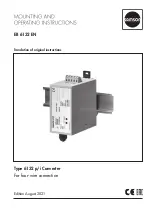
Section V. Parameter Function Table
47
f1
Output frequency
fb
V1
Vb
Output voltage
V1:Manual torque boost voltage
Vb:Maximum output voltage
f1:Cutt-off frequency of torque boost fb
:
Rated running frequency
Fig. 5-3 Manual torque boost schematic diagram
To compensate the low frequency torque characteristics of V/F control, boost compensation should
be made to inverter low frequency output voltage.
Torque hoist
:
it will be set according to the percentage of input rated voltage to the inverter. Below
are explanations of setting torque increase
:
1) When the torque hoist is set as 0.0%, the inverter will aYpt auto torque hoist.
2) This parameter can be properly hoisted for small motor, while for large motor; the parameter can
be properly decreased.
3) If the torque hoist is set to be too large, the motor may be overheated, and the inverter may be
over-current.
Torque hoist cut-off frequency
:
As shown in Fig. 5.3, the torque hoist is valid when the cutoff
frequency below this setting. Otherwise, the torque hoist will be invalid.
F3.03
Multi-point V/F frequency
point F1
0.00Hz~F3.05
0.00Hz
★
F3.04
Multi-point V/F voltage
point V1
0.0%~100.0%
0.0%
★
F3.05
Multi-point V/F frequency
point F2
F3.03~F3.07
0.00Hz
★
F3.06
Multi-point V/F voltage
point V2
0.0%~100.0%
0.0%
★
F3.07
Multi-point V/F frequency
point F3
F3.05~Motor rated frequency(F1.04)Note
:
Motor
2\3\4 rated frequency respectively
A2.04\A3.04\A4.04
0.00Hz
★
F3.08
Multi-point V/F voltage
point V3
0.0%~100.0%
0.0%
★
Six parameters of F3.03 to F3.08 define the multi-point V/F curve.
The setup value of multi-point V/F curve is generally set in accordance with the load characteristics
of the motor.
Caution
:
1) It must be set as follows
:
V1
<
V2
<
V3
,
F1
<
F2
<
F3. Fig5.4 is schematic diagram for multi-
point V/F curve.
2) If the voltage is set too high at the time of low frequency, it may cause overheating and even
burning of the motor as well as stall over current or over current protection of the inverter.
















































